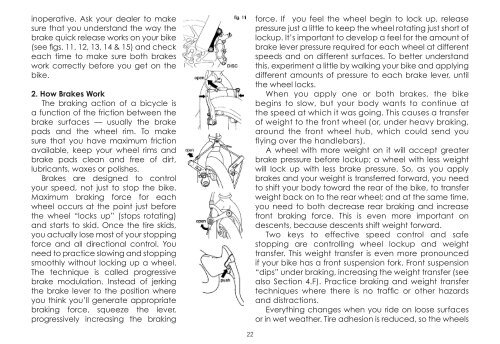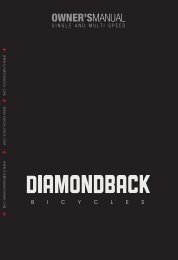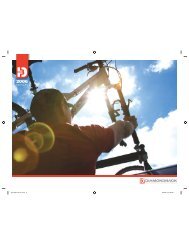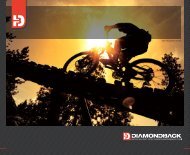Owner's Manual - Diamondback Bicycles
Owner's Manual - Diamondback Bicycles
Owner's Manual - Diamondback Bicycles
Create successful ePaper yourself
Turn your PDF publications into a flip-book with our unique Google optimized e-Paper software.
inoperative. Ask your dealer to makesure that you understand the way thebrake quick release works on your bike(see figs. 11. 12, 13. 14 & 15) and checkeach time to make sure both brakeswork correctly before you get on thebike.2. How Brakes WorkThe braking action of a bicycle isa function of the friction between thebrake surfaces — usually the brakepads and the wheel rim. To makesure that you have maximum frictionavailable, keep your wheel rims andbrake pads clean and free of dirt,lubricants, waxes or polishes.Brakes are designed to controlyour speed, not just to stop the bike.Maximum braking force for eachwheel occurs at the point just beforethe wheel “locks up” (stops rotating)and starts to skid. Once the tire skids,you actually lose most of your stoppingforce and all directional control. Youneed to practice slowing and stoppingsmoothly without locking up a wheel.The technique is called progressivebrake modulation. Instead of jerkingthe brake lever to the position whereyou think you’ll generate appropriatebraking force, squeeze the lever,progressively increasing the brakingforce. If you feel the wheel begin to lock up, releasepressure just a little to keep the wheel rotating just short oflockup. It’s important to develop a feel for the amount ofbrake lever pressure required for each wheel at differentspeeds and on different surfaces. To better understandthis, experiment a little by walking your bike and applyingdifferent amounts of pressure to each brake lever, untilthe wheel locks.When you apply one or both brakes, the bikebegins to slow, but your body wants to continue atthe speed at which it was going. This causes a transferof weight to the front wheel (or, under heavy braking,around the front wheel hub, which could send youflying over the handlebars).A wheel with more weight on it will accept greaterbrake pressure before lockup; a wheel with less weightwill lock up with less brake pressure. So, as you applybrakes and your weight is transferred forward, you needto shift your body toward the rear of the bike, to transferweight back on to the rear wheel; and at the same time,you need to both decrease rear braking and increasefront braking force. This is even more important ondescents, because descents shift weight forward.Two keys to effective speed control and safestopping are controlling wheel lockup and weighttransfer. This weight transfer is even more pronouncedif your bike has a front suspension fork. Front suspension“dips” under braking, increasing the weight transfer (seealso Section 4.F). Practice braking and weight transfertechniques where there is no traffic or other hazardsand distractions.Everything changes when you ride on loose surfacesor in wet weather. Tire adhesion is reduced, so the wheels22










